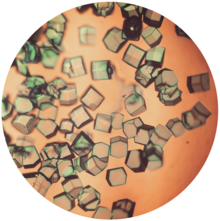리소자임
리소자임(리소짐, 라이소자임), 뮤라미데이스(영어: Lysozyme 또는 muramidase), N-acetylmuramide glycanhydrolase는 선천 면역의 일부를 형성하는, 동물에 의해 생성되는 항균성 효소이다. 리소자임은 그람 양성균 세포벽의 주성분인 펩티도글리칸의 N-아세틸무람산(N-acetylmuramic acid)과 N-아세틸-D-글루코사민(N-acetyl-D-glucosamine) 잔여물 사이의 1,4-베타 결합을 가수분해를 촉진시키는 글리코사이드 하이드로레이즈이다.[1] 즉, 이러한 가수분해는 세균의 용해를 일으켜서 세균세포벽의 온전성을 위태롭게 만든다.

리소자임은 눈물, 침, 모유, 점액을 포함한 분비물에 풍부하다. 또, 대식세포와 호중성 과립구(PMN)의 세포질 과립부에도 존재한다. 상당한 양의 리소자임은 달걀의 흰자에서 볼 수 있다. C형 리소자임은 서열과 구조 면에서 알파락토알부민과 밀접한 관계가 있으므로 동일한 계열에 속한다고 볼 수 있다.[2] 인간의 경우 리소자임 효소는 LYZ 유전자에 의해 암호화(encode)된다.[3][4]
리소자임은 열로부터 안정적인데, 녹는점은 pH 5.0에서 최대 72 °C까지 도달한다.[5] 그러나 모유의 경우 해당 온도에서 매우 빠르게 활동성을 잃는다.[6] 등전점은 11.35이다. 넓은 범위의 pH(6-9) 리소자임은 생존이 가능하다.[7]
역사
편집리소자임이 내포된 까닭에서 비롯되는 암탉의 달걀 흰자의 향균적 속성은 1909년 Laschtschenko에 의해 처음 발견되었으나,[8] "리소자임"이라는 이름은 1922년 페니실린을 두 번째로 발견한 과학자 알렉산더 플레밍에 의해 만들어졌다.[9][10]
리소자임은 1937년 에드워드 에이브러햄에 의해 처음 결정되었으며, 이를 통해 David Chilton Phillips가 1965년 암탉의 달걀 흰자의 리소자임의 3차원 구조를 기술할 수 있게 되었고 당시 David는 엑스선결정을 통해 처음 2-옹스트롬(200 pm) 해상 모델(resolution model)을 취득하였다.[11][12] 이 구조는 1965년 로열 인스티튜션의 강의에서 공개 발표되었다.[13] 리소자임은 X선 회절법을 통해 해결된 두 번째 단백질 구조이자 첫 번째 효소 구조였으며 20개의 모든 일반 아미노산을 포함하는 완전히 서열화된 최초의 효소였다.[14]
같이 보기
편집각주
편집- ↑ Manchenko GP (1994). 〈Lysozyme〉. 《Handbook of Detection of Enzymes on Electrophoretic Gels》. Boca Raton, Fla.: CRC Press. 223쪽. ISBN 978-0-8493-8935-1.
- ↑ Williams S, Vocadlo D. “Glycoside hydrolase family 22”. 《Cazypedia》. 2017년 4월 11일에 확인함.
- ↑ Yoshimura K, Toibana A, Nakahama K (January 1988). “Human lysozyme: sequencing of a cDNA, and expression and secretion by Saccharomyces cerevisiae”. 《Biochemical and Biophysical Research Communications》 150 (2): 794–801. doi:10.1016/0006-291X(88)90461-5. PMID 2829884.
- ↑ Peters CW, Kruse U, Pollwein R, Grzeschik KH, Sippel AE (July 1989). “The human lysozyme gene. Sequence organization and chromosomal localization”. 《European Journal of Biochemistry》 182 (3): 507–16. doi:10.1111/j.1432-1033.1989.tb14857.x. PMID 2546758.
- ↑ Venkataramani S, Truntzer J, Coleman DR (April 2013). “Thermal stability of high concentration lysozyme across varying pH: A Fourier Transform Infrared study”. 《Journal of Pharmacy & Bioallied Sciences》 5 (2): 148–53. doi:10.4103/0975-7406.111821. PMC 3697194. PMID 23833521.
- ↑ Chandan RC, Shahani KM, Holly RG (October 1964). “Lysozyme Content of Human Milk”. 《Nature》 204 (4953): 76–7. doi:10.1038/204076a0. PMID 14240122.
- ↑ “Lysozyme, Product information” (PDF). Sigma-Aldrich.
- ↑ Laschtschenko P (1909). “Über die keimtötende und entwicklungshemmende Wirkung Hühnereiweiß” [On the germ-killing and growth-inhibiting effect chicken egg albumin]. 《Z. Hyg. InfektKrankh.》 (독일어) 64: 419–427. doi:10.1007/BF02216170.
- ↑ “Duckett S. Ernest Duchesne and the concept of fungal antibiotic therapy. The Lancet Department Of Medical History 354(9195):2068-2071, December 11, 1999”.
- ↑ Fleming A (May 1922). “On a remarkable bacteriolytic element found in tissues and secretions”. 《en:Proceedings of the Royal Society B》 93 (653): 306–317. doi:10.1098/rspb.1922.0023. JSTOR 80959.
- ↑ Blake CC, Koenig DF, Mair GA, North AC, Phillips DC, Sarma VR (May 1965). “Structure of hen egg-white lysozyme. A three-dimensional Fourier synthesis at 2 Angstrom resolution”. 《Nature》 206 (4986): 757–61. doi:10.1038/206757a0. PMID 5891407.
- ↑ Johnson LN, Phillips DC (May 1965). “Structure of some crystalline lysozyme-inhibitor complexes determined by X-ray analysis at 6 Angstrom resolution”. 《Nature》 206 (4986): 761–3. doi:10.1038/206761a0. PMID 5840126.
- ↑ Johnson LN (November 1998). “The early history of lysozyme”. 《Nature Structural Biology》 5 (11): 942–4. doi:10.1038/2917. PMID 9808036.
- ↑ Canfield RE (August 1963). “The Amino Acid Sequence of Egg White Lysozyme”. 《The Journal of Biological Chemistry》 238 (8): 2698–707. PMID 14063294.